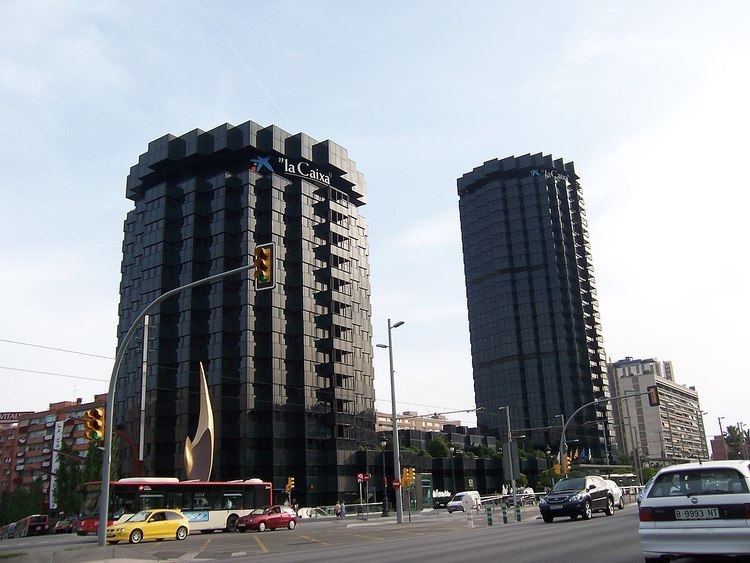Length 11 km (7 mi) To Sant Martí | ||
 | ||
Similar Diagonal Mar, Les Glòries shopping mall, Plaça de Catalunya, Gothic Quarter - Barcelona, Casa Milà | ||
Barcelona sightseeing avinguda diagonal in barcelona spain part 3 of 3
Avinguda Diagonal ([əβiŋˈɡuðə ðiəɣuˈnaɫ]) (in Spanish La Avenida Diagonal) is the name of one of Barcelona's broadest and most important avenues. It cuts the city in two, diagonally from west to east (by Barcelona's compass), hence the name.
Contents
- Barcelona sightseeing avinguda diagonal in barcelona spain part 3 of 3
- Map of Avinguda Diagonal Barcelona Spain
- Name
- Early history
- Recent history
- Architecture
- Shopping centres
- Cinemas
- Education
- Metro
- Tram
- References
Map of Avinguda Diagonal, Barcelona, Spain
It was originally projected by engineer and urban planner Ildefons Cerdà as one of the city's wide avenues, which along with Avinguda Meridiana would cut the rationalist grid he designed for l'Eixample (Catalan for extension). Both would meet at Plaça de les Glòries Catalanes, which Cerdà envisioned as the new city centre. However, Plaça Catalunya, equally a new addition to the city of Barcelona, and connecting Ciutat Vella and Eixample, and therefore occupying a more privileged position in the urban area, would finally become the centre. Avinguda Diagonal remains to this day a much-transited avenue and many companies and hotels use it as a privileged location, as can be seen in its architecture.
The avenue starts in the Les Corts district on the western edge of the city and runs to the Sant Martí district on the eastern edge. To its west, it connects with the Lleida-Madrid highway and Ronda de Dalt in the neighbouring municipality of Esplugues de Llobregat. To its east, it meets the Ronda del Litoral on the border with the municipality of Sant Adrià de Besòs. It is consistently 50 metres (160 ft) wide and about 11 kilometres (6.8 mi) long.
Name
The different regimes that held power in Catalonia and Spain during the 20th century sought to change the city's street names, and Avinguda Diagonal was permitted no exception. It has been known under the following names:
However, it should be noted that the name "Diagonal" has always prevailed in popular usage.
Early history
Ildefons Cerdà's so-called Pla Cerdà was not totally successful in transforming Barcelona's urban reality, as only parts of it were finally approved. The construction of Avinguda Diagonal is one of the projects it entailed that became reality, when a Royal Decree from Queen Isabella II of Spain and Leopoldo O'Donnell's Spanish government in Madrid allowed him to start the construction of the avenue in 1859. The city council of Barcelona had previously requested the approval of Antoni Rovira i Trias's alternative project instead, which had been rejected.
After the completion of its central section, from the current Plaça de Francesc Macià towards Glòries, it soon became one of Barcelona's most popular avenues and an ideal place for the Catalan aristocrats and bourgeoisie to exhibit their carriages. Francesc Cambó, leader of Lliga Regionalista proposed the construction of a new palace for the then monarch Alfonso XIII in 1919 (the royal palace in Ciutat Vella had been destroyed in the fire of 1875).
Recent history
Avinguda Diagonal suffered several attacks by the Basque separatist organisation ETA in 2000. On 2 November, a car bomb exploded injuring a security officer and a municipal officer. A few days later, on 21 November, a car used by the killers of Enerst Lluch exploded in the middle of the avenue. On 20 December a municipal officer was shot dead.
Four venues in the area hosted competitions for the 1992 Summer Olympics.
During 2010, Diagonal reform proposals were on the headlines, as the Barcelona city council had plans to make the tram cross the whole avenue. A popular consultation (the word referendum being banned by Spanish law) was scheduled for May 2010 between two reform proposals, the so-called rambla or boulevard. It resulted in a big political failure for the city mayor, Jordi Hereu. There was a bare participation of 12% of potential voters, and about 80% voted for the third option none of the former two, that is, against any change.
Architecture
Shopping centres
Cinemas
Education
Avinguda Diagonal is also home to several schools of both Universitat de Barcelona (UB) and Universitat Politècnica de Catalunya, in the area that is commonly known as Zona Universitària.
The following UB faculties and schools are located on the avenue:
Metro
The avenue is served by a number of metro stations:
Tram
Trambaix
Trambesòs
